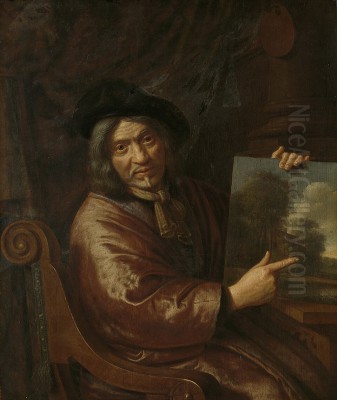
Pieter Jansz van Asch stands as a notable figure among the artists of the Dutch Golden Age, a period of extraordinary artistic flourishing in the Netherlands during the 17th century. Born in Delft in 1603, he dedicated his career primarily to the art of landscape painting, contributing to a genre that gained immense popularity and sophistication during his lifetime. While primarily recognized for his evocative depictions of the Dutch countryside, Van Asch also engaged in designing stained glass and creating designs for prints, showcasing a breadth of artistic skill. He passed away in his native Delft around 1678, leaving behind a body of work appreciated for its detail and atmospheric quality.
It is crucial, however, to distinguish Pieter Jansz van Asch from other Dutch artists bearing similar names, particularly Pieter Jansz Saenredam (1597–1665). Saenredam was a contemporary but specialized in a markedly different genre: architectural painting, specifically the precise and luminous interiors of churches. Another artist, Pieter Jansz. Quast (c. 1605/06–1647), focused more on genre scenes and figure painting, often with a satirical edge, differing significantly from Van Asch's landscape focus. Understanding these distinctions is key to appreciating Van Asch's specific contributions to Dutch art.
Biographical Sketch and Delft Connections
Details about Pieter Jansz van Asch's personal life remain relatively scarce, a common situation for many artists of his time whose fame did not reach the absolute pinnacle of contemporaries like Rembrandt van Rijn or Johannes Vermeer. We know he was born in Delft in 1603, the son of the portrait painter Jan van Asch. This familial connection likely provided his initial exposure to the world of art. His artistic training probably occurred within Delft, a vibrant artistic center rivaling Amsterdam and Haarlem.
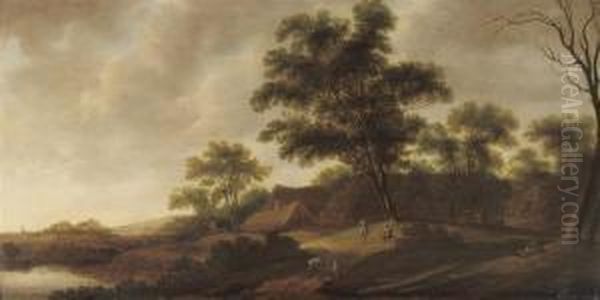
Evidence points to his establishment as an independent master relatively early in his career. In 1623, he became a member of the Guild of Saint Luke in Delft. This membership was essential for artists wishing to practice professionally, take on apprentices, and sell their work within the city. His continued presence in Delft throughout his life suggests a strong connection to the city and its artistic community. While records mention interactions, such as a connection with a pastor named Pieter Jan Foppesz, details regarding his marriage, family beyond his father, or specific personal motivations behind his art are not well-documented, leaving aspects of his life story open to interpretation based on his work and the context of his time.
Artistic Style: Landscapes of the Dutch Republic
Pieter Jansz van Asch's primary contribution lies in the field of landscape painting. His work aligns with the broader trends in Dutch landscape art during the Golden Age, which moved towards naturalism and the depiction of the local environment. His style often reflects the influence of Jan van Goyen (1596–1656), one of the leading pioneers of tonal landscape painting in the Netherlands. This influence is visible in Van Asch's use of subtle colour palettes, often dominated by greens, browns, and greys, and his attention to atmospheric effects – the rendering of light, air, and weather.
Van Asch typically depicted serene views of the Dutch countryside: river landscapes, wooded areas, country roads, and villages. His compositions often feature a low horizon line, allowing for expansive skies that capture the particular quality of Dutch light. While influenced by the tonal phase associated with Van Goyen and Salomon van Ruysdael (c. 1602–1670), Van Asch's works often retain a greater degree of detail and local colour than the more monochromatic works of his influences, perhaps reflecting a slightly later sensibility or a personal preference for clarity.
Figures frequently populate Van Asch's landscapes, but they usually remain small in scale, serving to animate the scene and provide a sense of everyday life rather than dominating the composition. These might include travellers resting by a roadside, peasants working in fields, or boats navigating a river. The careful observation of nature, particularly the rendering of trees and foliage, is a characteristic feature of his work. His engagement with glass painting and print design also suggests a strong capacity for detailed drawing and composition, skills that would undoubtedly inform his landscape paintings.
Distinguishing Van Asch from Namesakes
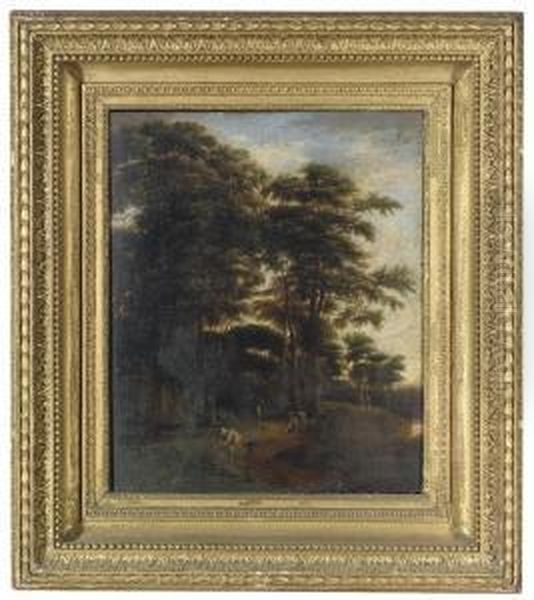
The potential for confusion between Pieter Jansz van Asch and Pieter Jansz Saenredam necessitates a clear distinction. Saenredam was almost exclusively an architectural painter, renowned for his meticulous, almost scientifically accurate renderings of church interiors and, occasionally, exteriors. His works are characterized by their bright illumination, clean lines, complex perspective, and a profound sense of stillness and order, often depicting the whitewashed interiors of Protestant churches after the Reformation. Masterpieces like his views of the Interior of the Grote Kerk at Haarlem or the Interior of the Buurkerk in Utrecht exemplify his unique focus and style.
Pieter Jansz van Asch, conversely, rarely ventured into architectural interiors. His domain was the external world, the natural or semi-rural landscape. While buildings might appear in his scenes, they function as elements within a broader landscape context, not as the primary subject demanding detailed architectural study in the manner of Saenredam. His focus was on atmosphere, terrain, vegetation, and the interplay of light and shadow across the land.
Similarly, Pieter Jansz. Quast, though also active in the first half of the 17th century, had a different artistic personality. Quast is known for his lively, often humorous or satirical genre scenes depicting peasants, soldiers, and theatrical figures, as well as some landscapes and portraits. His style is generally looser and more caricatural than Van Asch's detailed naturalism. Therefore, while sharing the patronymic "Jansz," these three artists occupied distinct niches within the diverse landscape of Dutch Golden Age painting.
Representative Works and Themes
While a comprehensive catalogue of Van Asch's work requires specialist study, certain themes and specific pieces stand out. His oeuvre largely consists of variations on Dutch landscape themes: tranquil river views often featuring ferry boats or fishermen, wooded paths with travellers or hunters, and panoramic views across the flat Dutch countryside dotted with windmills or distant village spires. These works capture the specific character of the Dutch environment, reflecting a national pride in the reclaimed and cultivated land.
One painting with a particularly notable history is The Stop. This work depicts a landscape scene, typical of his style. Its significance extends beyond the artistic, however, as it became entangled in the tragic events of World War II. The painting was looted by the Nazis from the collection of Josef Wiener, a Jewish banker in Prague. After the war, it was recovered but mistakenly restituted to France before eventually being identified and returned to Wiener's rightful heirs. This story highlights the complex provenance histories that can attach to artworks, connecting them to broader historical narratives.
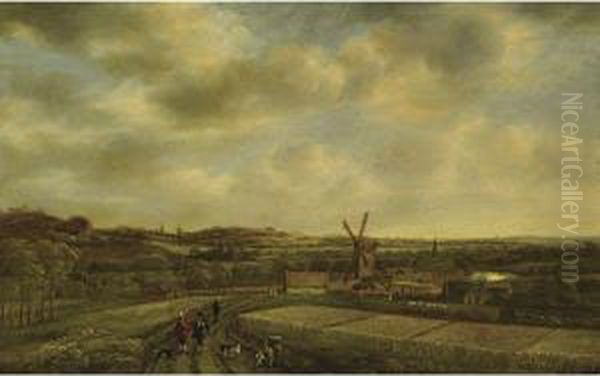
Other works, often titled descriptively like River Landscape with Figures, Wooded Landscape with Travelers, or View of a Village, populate museum collections and appear in the art market. They consistently demonstrate his skill in rendering the textures of nature, the effects of light, and the quietude of the Dutch countryside. His works offer a peaceful, ordered vision of the world, characteristic of much Dutch landscape painting of the era.
Influences, Contemporaries, and Artistic Circle
Pieter Jansz van Asch operated within a rich artistic milieu. As mentioned, the influence of Jan van Goyen is palpable in his tonal approach and subject matter. He would also have been aware of other leading landscape painters of the preceding and contemporary generations, such as Esaias van de Velde (c. 1587–1630), known for his early realistic landscapes, and Hendrick Avercamp (1585–1634), famous for his winter scenes. Salomon van Ruysdael, another master of the tonal river landscape, represents a close artistic relative.
Living and working in Delft placed Van Asch in proximity to other major talents. Although specializing in different genres, he would have been aware of figures like Johannes Vermeer (1632–1675) and Carel Fabritius (1622–1654) during their active years in the city. While direct collaboration or influence might not be documented, the shared environment fostered a high level of artistic quality and likely some degree of mutual awareness among Delft artists.
The source material also suggests potential influences from artists outside the immediate Dutch landscape tradition. The mention of Jacques Callot (1592–1635), a French printmaker known for his detailed etchings of figures and scenes, might relate to Van Asch's own work in print design or his handling of figures within landscapes. Similarly, the influence of the Flemish genre painter Adriaen Brouwer (c. 1605–1638), known for his lively peasant scenes, could point towards an inspiration for the small figures animating Van Asch's landscapes.
Furthermore, Van Asch is noted as having influenced later painters. Cornelis van Biezen (active c. 1642-1661) is mentioned as a possible pupil or follower. The connection to Abraham van Beijeren (c. 1620–1690), a prominent still-life painter also active in Delft for a time, is less direct stylistically but might reflect shared artistic circles or broader 17th-century Dutch artistic sensibilities. Herman Saftleven the Younger (1609–1685), known for his detailed landscapes and topographical views, is another contemporary whose work shares some common ground in terms of detailed observation, although Saftleven often depicted more mountainous or fantastical scenes alongside his Dutch views.
Collections, Exhibitions, and Legacy
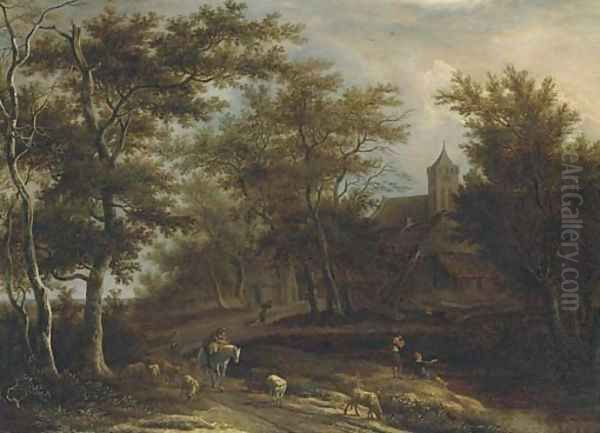
Works by Pieter Jansz van Asch are held in various public and private collections, though perhaps not as ubiquitously as those by the very top tier of Dutch masters. The Rijksmuseum in Amsterdam, the premier museum for Dutch art, holds examples of his designs for stained glass and heraldic works, attesting to the diversity of his output beyond panel painting. His landscape paintings can be found in numerous museums across Europe and North America.
His works occasionally appear at auction, as evidenced by the mention of a painting being sold at Stockholm Auktioner AB. Exhibition history can be complex to trace definitively, especially given the potential confusion with Pieter Jansz Saenredam. While exhibitions like "Le Paysage Hollandais au XVIIe Siècle" (Paris, Musée de l'Orangerie) or "Tentoonstelling Kunstbezit van Oud-Alumni Der Leidse Universiteit" (Leiden, Stedelijk Museum Lakenhal) may have included works by Van Asch as a representative of Dutch landscape, specific attributions within older exhibition records require careful verification. Exhibitions focused purely on architectural painting, or featuring works like Saenredam's Interior of the Church of St. Bavo (held by the National Gallery of Art, Washington D.C.), would primarily showcase Saenredam, not Van Asch.
Pieter Jansz van Asch's legacy is that of a skilled and productive landscape painter firmly rooted in the Dutch Golden Age tradition. While perhaps overshadowed by innovators like Jacob van Ruisdael (c. 1628–1682) or the more prolific Jan van Goyen, Van Asch consistently produced appealing, well-crafted views of his native land. His paintings offer valuable insights into the Dutch appreciation for their environment and the artistic conventions used to depict it during the 17th century. He remains a respected figure within the extensive school of Dutch landscape painting, admired for his careful technique and the tranquil atmosphere of his works.
Conclusion: An Enduring Vision of the Dutch Landscape
Pieter Jansz van Asch navigated the bustling art world of the Dutch Golden Age as a dedicated landscape specialist. Born and based in the artistic hub of Delft, he absorbed the influences of leading figures like Jan van Goyen while developing his own distinct, detailed approach to depicting the Dutch countryside. His membership in the Delft Guild of St. Luke and his documented works, including the historically significant painting The Stop, confirm his status as a professional artist of repute.
Though sometimes confused with namesakes like the architectural painter Pieter Jansz Saenredam, Van Asch's contribution lies squarely within the realm of landscape. His river scenes, wooded paths, and village views, rendered with careful attention to detail and atmospheric nuance, capture a serene and enduring vision of the Netherlands in the 17th century. His work, found in collections like the Rijksmuseum and appreciated by connoisseurs of the period, continues to offer a window onto the world of the Dutch Golden Age and the profound connection its artists felt with their native land. He remains an important representative of the depth and breadth of talent that characterized this remarkable era in art history.